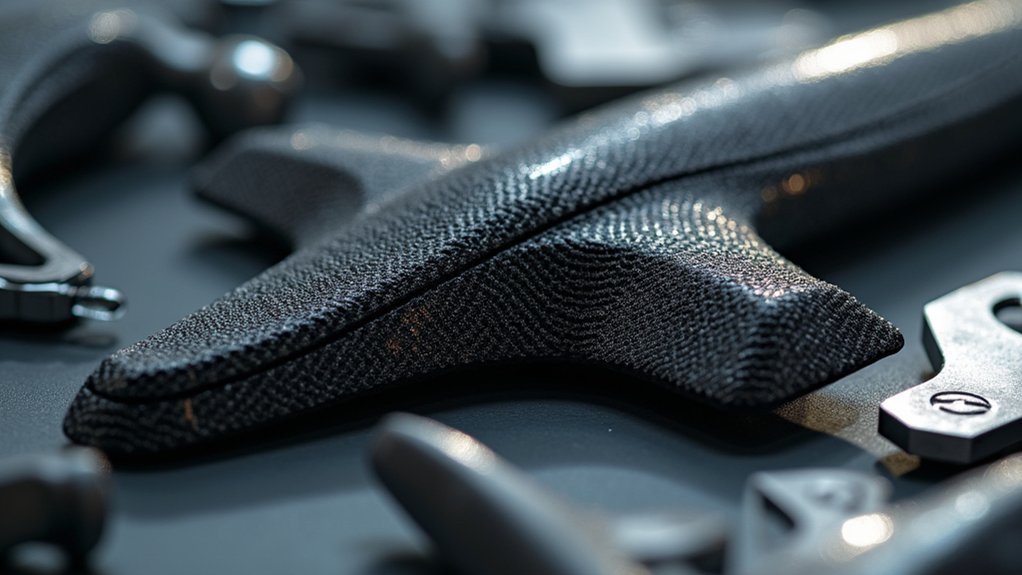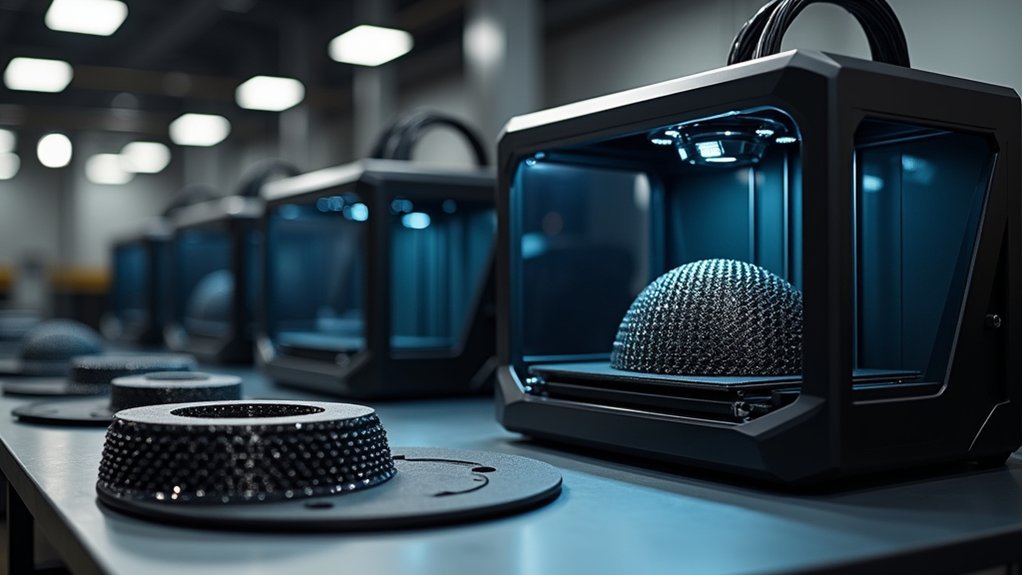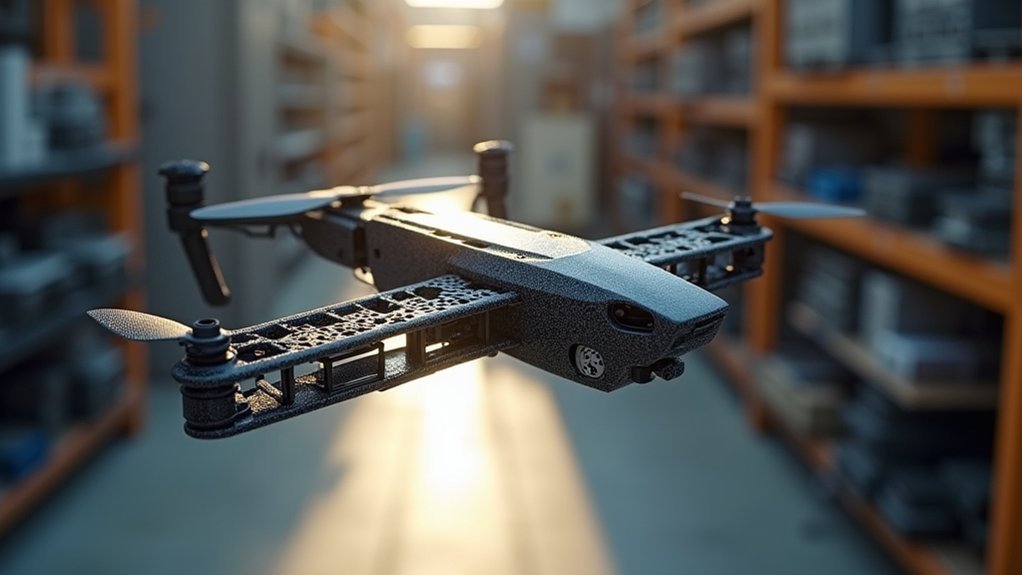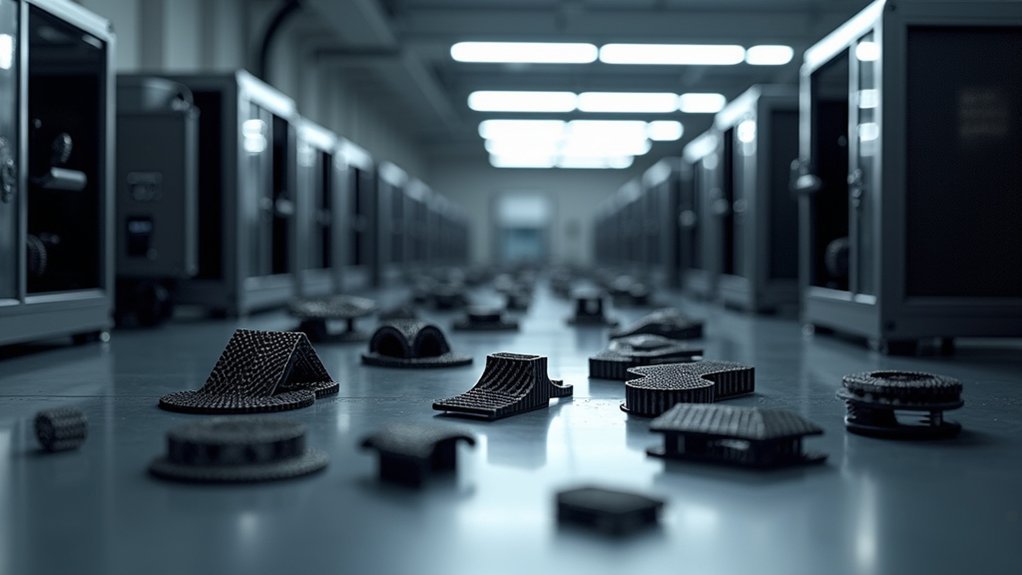You’ll find carbon fiber 3D printing revolutionizes industries through aerospace components like lightweight aircraft brackets and satellite structures, automotive parts that reduce weight and improve fuel efficiency, manufacturing tooling including custom jigs and fixtures, composite molds for traditional production, robotic arms with superior strength-to-weight ratios, marine vehicle parts with exceptional corrosion resistance, energy sector equipment like wind turbine blades, and medical device housings that offer sterilization benefits. These applications showcase how this technology transforms manufacturing capabilities and performance standards across multiple sectors.
Aerospace Components and Lightweight Structures

As aerospace engineers push the boundaries of aircraft design, carbon fiber 3D printing has emerged as a game-changing technology for creating lightweight components that don’t compromise on strength.
You’ll find this technology revolutionizing how manufacturers produce aircraft brackets, panels, and satellite structures. The exceptional strength-to-weight ratio of carbon fiber enables you to construct components that withstand harsh space conditions while markedly reducing overall weight.
When you implement carbon fiber 3D printing for aerospace components, you’re achieving remarkable fuel efficiency gains—even a 1% weight reduction translates to 1% fuel savings.
This technology allows you to design complex geometries that traditional manufacturing methods simply can’t achieve, pushing lightweight structures beyond conventional limitations while maintaining structural integrity throughout demanding flight operations.
Automotive Parts and Performance Enhancements
Moving from the skies to the road, carbon fiber 3D printing transforms how you manufacture automotive parts with unprecedented speed and precision.
You’ll reduce production lead times from months to weeks while creating custom components and rapid prototypes.
These lightweight parts dramatically improve your vehicle’s performance by reducing overall weight, enhancing fuel efficiency and driving range—especially critical for high-performance and electric vehicles.
You can design complex shapes that optimize aerodynamics and reduce drag, while suspension components, body panels, and steering wheels deliver superior strength and stiffness.
The durability of carbon fiber parts guarantees they withstand high stress and harsh environmental conditions, making them perfect for racing applications where performance enhancements and reliability are paramount.
Manufacturing Tooling and Production Aids

Beyond vehicle components themselves, carbon fiber 3D printing revolutionizes your manufacturing processes by creating superior tooling and production aids.
Carbon fiber 3D printing transforms manufacturing beyond parts production, delivering revolutionary tooling solutions that enhance precision and efficiency.
You’ll discover that carbon fiber composites deliver exceptional manufacturing tooling solutions that outperform traditional materials in both strength and heat resistance.
Your production benefits include:
- Custom jigs and fixtures – Rapid iterations and modifications reduce lead times considerably
- Lightweight handling – Reduced operator fatigue and improved ergonomics during assembly
- Dimensional stability – Superior mechanical properties guarantee consistent accuracy
- Cost-effective molds – Durable composite manufacturing solutions with minimal post-processing
When you implement carbon fiber tooling, you’re investing in enhanced production efficiency across automotive and aerospace industries.
The material’s exceptional mechanical properties provide the durability needed for high-volume manufacturing while maintaining precision throughout extended use.
Jigs, Fixtures, and Assembly Equipment
You’ll find that carbon fiber 3D printing transforms your assembly operations by enabling custom jig designs tailored to your specific production requirements.
Your fixtures can withstand extreme manufacturing environments while maintaining precision, thanks to carbon fiber’s exceptional high-temperature performance characteristics.
You’re able to rapidly produce tooling on-demand, eliminating lengthy procurement cycles and adapting quickly to design changes or new product introductions.
Custom Jig Design
Precision drives every successful manufacturing operation, and custom jig design represents one of the most transformative applications of carbon fiber 3D printing in industrial settings.
You’ll find that carbon fiber composites deliver exceptional durability while maintaining lightweight characteristics that reduce operator fatigue during assembly tasks. The rapid prototyping capabilities enable you to create tailored solutions for specific manufacturing processes without extensive lead times.
Key advantages of carbon fiber custom jigs include:
- Enhanced dimensional stability that minimizes warping and guarantees precise alignment
- Superior strength-to-weight ratio compared to traditional metal fixtures
- Significant cost reduction while maintaining geometric flexibility for complex designs
- Improved workplace ergonomics through reduced weight and operator strain
You’ll achieve better production efficiency and assembly precision while accommodating intricate geometries that traditional materials can’t match.
High-Temperature Fixture Performance
When manufacturing processes demand exposure to extreme temperatures, carbon fiber 3D printed fixtures deliver unmatched thermal stability that traditional materials simply can’t provide.
You’ll find these carbon fiber fixtures maintain their structural integrity even under extreme heat, making them perfect for aerospace and automotive applications where traditional tooling would fail.
The lightweight properties don’t compromise performance—you’re getting superior dimensional stability that prevents warping in high-temperature environments.
This means you’ll achieve tighter tolerances and improved product quality consistently. You can rapid prototype new designs quickly, allowing immediate adaptation for specific assembly tasks.
Your manufacturing processes benefit from reduced downtime while maintaining precision across temperature variations that would destroy conventional fixtures.
Rapid Tooling Production
While traditional tooling production can take weeks or months, carbon fiber 3D printing transforms your manufacturing timeline by producing custom jigs, fixtures, and assembly equipment in days.
This rapid tooling production revolutionizes your manufacturing processes by eliminating outsourcing dependencies and accelerating project timelines.
Carbon fiber materials deliver exceptional benefits for your tooling needs:
- Enhanced durability and performance – Withstands repeated use in demanding manufacturing environments
- Lightweight operator comfort – Reduces assembler strain during extended assembly tasks
- Custom jigs and fixtures – Perfectly tailored fit for specific manufacturing requirements
- Functional prototype testing – Real-life strain testing guarantees structural integrity before production
Your printed jigs can undergo rigorous testing to validate performance standards.
Companies shifting to in-house carbon fiber solutions report dramatically reduced lead times compared to traditional tooling methods.
Composite Molds for Traditional Manufacturing
As manufacturers seek alternatives to expensive traditional tooling, carbon fiber 3D printing has emerged as a game-changing solution for creating composite molds that deliver both durability and cost-effectiveness.
You’ll find these carbon fiber composites enable complex geometries that greatly reduce production costs while maintaining exceptional performance standards.
When you’re working with thermoforming applications, these molds withstand repeated high-heat usage without compromising structural integrity.
The additive manufacturing process allows you to rapidly iterate designs and customize specifications for small batch production, dramatically increasing efficiency compared to traditional manufacturing methods.
You’ll benefit from enhanced dimensional stability that reduces shrinkage and warping issues.
Industries like automotive and aerospace particularly value these high strength, lightweight properties that improve overall product performance while streamlining manufacturing processes.
Drone and UAV Structural Components

Because drone and UAV performance hinges on achieving ideal weight-to-strength ratios, carbon fiber 3D printing has revolutionized how you’ll design and manufacture critical structural components.
Carbon fiber composites deliver exceptional lightweight properties while maintaining structural integrity under dynamic flight loads.
You’ll benefit from these key advantages:
- Enhanced Flight Performance – Lightweight frames and propellers extend flight times and improve maneuverability
- Superior Durability – Components withstand harsh environmental conditions while maintaining performance standards
- Rapid Prototyping – Fast production enables quick customization for specific mission requirements
- Complex Geometries – Continuous fiber printing creates intricate designs impossible with traditional manufacturing
UAV components made through this technology demonstrate remarkable resilience in both recreational and commercial applications, making carbon fiber 3D printing indispensable for modern drone manufacturing.
Robotic Arms and Automation Equipment
You’ll find carbon fiber 3D printing transforms robotic systems by enabling lightweight end effectors that maintain exceptional strength while reducing inertia during high-speed operations.
Your structural frame components benefit from carbon fiber’s superior strength-to-weight ratio, allowing you to build robotic arms that handle heavier payloads without sacrificing precision or speed.
Custom gripper assemblies become possible through additive manufacturing, letting you create intricate geometries that enhance gripping performance while keeping overall system weight minimal.
Lightweight End Effectors
Precision becomes paramount when robotic arms must execute repetitive tasks at lightning speed while handling substantial payloads.
You’ll discover that carbon fiber 3D printing revolutionizes end effector design by delivering exceptional light weight components without compromising strength. The high strength-to-weight ratio enables your automation systems to achieve faster cycle times while maintaining energy efficiency.
Carbon fiber’s dimensional stability guarantees consistent performance across demanding industrial applications:
- Reduced overall system weight enhances speed and agility
- Minimal wear and tear extends service life considerably
- Complex geometries enable task-specific functionality
- Lower maintenance costs improve operational efficiency
You can create customized end effectors tailored to specific manufacturing requirements, optimizing your automation processes.
This technology transforms how you approach robotic system design, delivering superior performance while reducing operational costs.
Structural Frame Components
While end effectors handle the precise work, the structural backbone of your robotic systems demands equal attention to weight optimization and strength. Carbon fiber composites transform structural frame components through advanced manufacturing process capabilities, delivering exceptional tensile strength up to 2400 MPa while maintaining lightweight characteristics.
| Performance Metric | Traditional Materials | Carbon Fiber 3D Printed |
|---|---|---|
| Weight Reduction | Baseline | Up to 50% lighter |
| Tensile Strength | Standard steel levels | Up to 2400 MPa |
| Design Complexity | Limited geometries | Complex shapes achievable |
| Production Timeline | Months | Weeks |
You’ll achieve superior design freedom with intricate geometric shapes that weren’t possible before. This lightweight approach improves energy efficiency and movement speed while reducing overall assembly weight, making your automation equipment more responsive and cost-effective.
Custom Gripper Assemblies
Beyond structural components, carbon fiber 3D printing revolutionizes custom gripper assemblies where precision meets demanding performance requirements.
You’ll discover that carbon fiber composites deliver exceptional capabilities for robotic automation applications.
When you’re designing custom gripper assemblies, you’ll benefit from these key advantages:
- Superior Performance: High strength-to-weight ratios enhance your robotic arm’s speed and agility during operation
- Dimensional Precision: Exceptional stability prevents warping, ensuring perfect fit for intricate designs
- Industrial Durability: Resistance to wear handles repetitive tasks in demanding manufacturing environments
- Development Speed: Rapid prototyping through 3D printing greatly reduces your lead times compared to traditional methods
You’ll find that integrating carbon fiber into your gripper designs creates lightweight solutions without compromising durability, making them ideal for high-performance automation equipment.
Marine and Underwater Vehicle Parts
The ocean’s harsh environment demands materials that can withstand relentless saltwater corrosion, crushing pressures, and constant mechanical stress—challenges that carbon fiber 3D printing addresses with remarkable effectiveness.
You’ll find carbon fiber composites transforming marine applications through their exceptional corrosion resistance and lightweight properties, making them perfect for hulls, structural reinforcements, and critical components in boats and underwater vehicles.
When you’re designing propellers, rudders, or specialized marine equipment, you’ll benefit from the high strength-to-weight ratio that enhances performance and fuel efficiency.
ROVs particularly leverage these advantages, maintaining maneuverability while withstanding extreme pressure environments.
Advanced 3D printing techniques enable rapid prototyping and customization, allowing you to meet specific operational requirements quickly.
From fishing gear to underwater inspection devices, carbon fiber parts reduce operator burden while maximizing operational effectiveness.
Energy Sector Equipment and Wind Turbine Components
Efficiency demands drive the energy sector’s adoption of carbon fiber 3D printing, where turbine manufacturers harness these advanced composites to create components that outperform traditional materials in every critical metric.
You’ll discover that carbon fiber composites enable revolutionary wind turbine components that transform energy generation capabilities.
The 3D printing of carbon fiber delivers unprecedented advantages for energy sector equipment:
- Enhanced Performance: Lightweight blades improve energy capture by up to 20% through superior aerodynamics
- Extreme Durability: Components withstand harsh environmental conditions including high winds and temperature extremes
- Rapid Innovation: Quick prototyping and customization accelerate design improvements and production timelines
- Environmental Impact: Reduced carbon footprint supports sustainability goals by minimizing manufacturing and transportation emissions
You’re witnessing how these technologies revolutionize renewable energy infrastructure.
Medical Device Housings and Surgical Instruments
Precision saves lives in healthcare, and carbon fiber 3D printing transforms how medical professionals approach device manufacturing and surgical procedures.
Carbon fiber 3D printing revolutionizes medical device manufacturing, delivering precision-engineered solutions that directly enhance surgical outcomes and save lives.
When you’re designing medical device housings, carbon fiber composites deliver lightweight and durable solutions that reduce fatigue during extended procedures. You’ll find surgical instruments crafted from these materials offer high strength and rigidity while maintaining precision throughout complex operations.
The technology’s customization capabilities enable you to create patient-specific tools and implants, directly improving surgical outcomes. You can sterilize carbon fiber devices repeatedly without material degradation, ensuring safety standards remain uncompromised.
Weight reductions of up to 50% compared to traditional materials enhance operating room ergonomics, allowing you to work more efficiently while maintaining the corrosion resistance essential for sterile environments.
Frequently Asked Questions
What Are the Applications of Carbon Fiber 3D Printing?
You’ll find carbon fiber 3D printing creates lightweight aerospace components, custom automotive parts, high-performance sports equipment, personalized medical prosthetics, and efficient renewable energy components like wind turbine blades, enhancing performance across industries.
What Are the Industrial Uses of Carbon Fiber?
You’ll find carbon fiber used across aerospace for lightweight aircraft parts, automotive for performance components, sports equipment like bike frames, renewable energy turbine blades, and medical prosthetics requiring strength and durability.
What Can You Make With a Carbon Fiber 3D Printer?
You can create lightweight aerospace components, custom jigs and fixtures, high-performance sports equipment like bike frames, rapid prototyping molds for manufacturing, and medical devices including prosthetics that require exceptional strength-to-weight ratios.
What Is the Best Material for 3D Printing Industrial Use?
You’ll find carbon fiber reinforced filaments like PA12 CF and HI-TEMP CF are top choices for industrial 3D printing, offering exceptional strength-to-weight ratios and superior mechanical performance over standard thermoplastics.





Leave a Reply